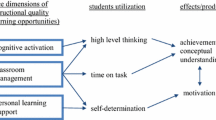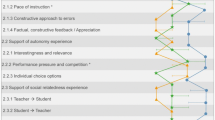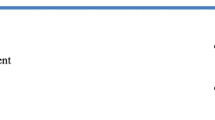Abstract
Recent evidence demonstrates that mathematics knowledge in the early years is an important contributor to students’ learning and later achievement in mathematics. As early mathematics education has assumed heightened importance, the quality of early mathematics teaching and learning experiences has attracted global attention. Several researchers have designed and used a number of instruments to measure and portray the quality of mathematics teaching in early childhood classrooms. As this body of work is growing fast, it is imperative to explore similarities and differences among the existing research tools that aim to measure the quality of early mathematics instruction. This paper takes a step towards exploring such similarities and differences by reviewing six observation instruments designed to measure early mathematics teaching quality. Therefore, the aim of this paper is twofold: (1) to provide an up-to-date overview by examining these measures’ theoretical bases, foci, and psychometrics; and (2) to examine the similarities and differences between the reviewed tools.
Similar content being viewed by others
References
Aunio, P., & Niemivirta, M. (2010). Predicting children’s mathematical performance in grade one by early numeracy. Learning and Individual Differences,20, 427–435.
Aunola, K., Leskinen, E., Lerkkanen, M. K., & Nurmi, J. E. (2004). Developmental dynamics of math performance from preschool to grade 2. Journal of Educational Psychology,96(4), 699–713.
Bahr, D. L., & De Garcia, L. A. (2010). Elementary mathematics is anything but elementary. Belmont: Wadsworth, Cengage Learning.
Ball, D. L., & Rowan, B. (2004). Introduction: Measuring instruction. Elementary School Journal,105(1), 3–10.
Baumert, J., Kunter, M., Blum, W., Brunner, M., Voss, T., Jordan, A., et al. (2010). Teachers’ mathematical knowledge, cognitive activation in the classroom, and student progress. American Educational Research Journal,47, 133–180.
Bodovski, K., & Farkas, G. (2007). Mathematics growth in early elementary school: The roles of beginning knowledge, student engagement and instruction. The Elementary School Journal,108(2), 115–130.
Boston, M. (2012). Assessing instructional quality in mathematics. The Elementary School Journal,113(1), 76–104.
Boston, M., & Wolf, M. K. (2006). Assessing academic rigor in mathematics instruction: The development of the instructional quality assessment toolkit (CSE Technical Report 672). Los Angeles: National Center for Research on Evaluation, Standards, and Student Testing (CRESST). Retrieved December 16, 2010, from http://eric.ed.gov/PDFS/ED492868.pdf.
Charalambos, Y. C., & Hill, H. C. (2012). Teacher knowledge, curriculum materials, and quality of instruction: Unpacking a complex relationship. Journal of Curriculum Studies,44(4), 443–466.
Clements, D. H., & Sarama, J. (2008). Experimental evaluation of the effects of a research-based preschool mathematics curriculum. American Educational Research Journal,45(2), 443–494.
Doabler, C. T., Baker, S. K., Kosty, D., Smolkowski, K., Clarke, B., Miller, S. J., et al. (2015). Examining the association between explicit mathematics instruction and student mathematics achievement. Elementary School Journal,111, 1–24.
Duncan, G. J., Dowsett, C. J., Claessens, A., Magnuson, K., Huston, A. C., Klebanov, P., et al. (2007). School readiness and later achievement. Developmental Psychology,43, 1428–1446.
Duncan, G., & Magnuson, K. (2011). The nature and impact of early achievement skills, attention skills, and behavior problems. In G. Duncan & R. Murnane (Eds.), Whither opportunity?: Rising inequality, schools, and children’s life chances (pp. 47–70). New York: Russell Sage Foundation.
Eisenhart, M. A. (1991). Conceptual frameworks for research circa 1991: Ideas from a cultural anthropologist: implications for mathematics education researchers. In Proceedings of the 13th annual meeting of the North American Chapter of the International Group for the Psychology of Mathematics Education (Vol. 1, pp. 202–219). Blacksburg, VA.
Entwisle, D. R., & Alexander, K. L. (1990). Beginning school math competence: Minority and majority comparisons. Child Development,61, 454–471.
Gay, L. R. (1987). Educational research: Competencies for analysis and application (3rd ed.). Columbus, OH: Merrill.
Ginsburg, H., Lee, J., & Byod, J. (2008). Mathematics education for young children: What it is and how to promote it. Society for Research in Child Development, Social Policy Report,22, 3–22.
Gleason, J., Livers, S. D., & Zelkowski, J. (2015). Mathematics classroom observation protocol for practices: Descriptors manual. Retrieved from http://igleason.people.ua.edu/mcop2.html.
Gleason, J., Livers, S. D., & Zelkowski, J. (2017). Mathematics classroom observation protocol for practices (MCOP2): A validation study. Investigations in Mathematics Learning,9(3), 111–129.
Griffin, S., Case, R., & Siegler, R. (1994). Rightstart: Providing the central conceptual prerequisites for first formal learning of arithmetic to students at risk for school failure. In K. McGilly (Ed.), Classroom lessons: Integrating cognitive theory and classroom practice (pp. 24–49). Cambridge, MA: MIT Press.
Grossman, P., & McDonald, M. (2008). Back to the future: Directions for research in teaching and teacher education. American Educational Research Journal,45(1), 184–205.
Hiebert, J., & Grouws, D. A. (2007). The effects of classroom mathematics teaching on students’ learning. In F. K. Lester Jr. (Ed.), Second handbook of research on mathematics teaching and learning (pp. 371–404). Charlotte, NC: Information Age.
Hill, H. C., Blunk, M., Charalambous, C., Lewis, J., Phelps, G., Sleep, L., et al. (2008). Mathematical knowledge for teaching and the mathematical quality of instruction: An exploratory study. Cognition and Instruction,26(4), 430–511.
Hill, H. C., Charalambous, C. Y., & Kraft, M. A. (2012). When rater reliability is not enough: Teacher observation systems and a case for the G-study. Educational Researcher,41(2), 56–64.
Horizons Research Inc. (2000). Inside the classroom observation and analytic protocol. Chapel Hill: Horizon Research Inc.
Kelcey, B., & Carlisle, J. F. (2013). Learning about teachers’ literacy instruction from classroom observations. Reading Research Quarterly,48(3), 301–317.
Kraft, M. A., & Hill, H. C. (2018). Developing ambitious mathematics instruction through web-based coaching: An randomized field trail. Brown University Working Paper.
Lawson, A., Benford, R., Bloom, I., Carlson, M., Falconer, K., Hestenes, D., et al. (2002). Evaluating college science and mathematics instruction. Journal of College Science Teaching,31, 388–393.
Learning Mathematics for Teaching. (2014). A Coding rubric for mathematics quality of instruction (MQI) 4-point version. Unpublished version.
Learning Mathematics for Teaching Project. (2011). Measuring the mathematics quality of instruction. Journal of Mathematics Teacher Education, 14, 25–47.
Leinhardt, G. (1993). Weaving instructional explanations in history. British Journal of Educational Psychology,63(1), 46–74.
Lysaght, Z. (2011). Epistemological and paradigmatic ecumenism in “Pasteur’s Quadrant:” Tales from doctoral research. In Official Conference Proceedings of the Third Asian Conference on Education in Osaka, Japan. Retrieved from http://iafor.org/ace2011_offprint/ACE2011_offprint_0254.pdf.
Marcoulides, G. A. (1993). Maximizing power in generalizability studies under budget constraints. Journal of Educational Statistics,18(2), 197–206.
National Research Council. (2009). Mathematics in early childhood: Learning paths toward excellence and equity. Washington, DC: National Academy Press.
Pianta, R. C., & Hamre, B. K. (2009). Conceptualization, measurement, and improvement of classroom processes: Standardized observation can leverage capacity. Educational Researcher,38, 109–119.
Piburn, M., Sawada, D., Turley, J., Falconer, K., Benford, R., Bloom, I., et al. (2000). Reformed teaching observation protocol (RTOP): Reference manual No. ACEPT Technical Report No. IN00-3. Tempe, AZ: Arizona Collaborative for Excellence in the Preparation of Teachers.
Praetorius, A.-K., Pauli, C., Reusser, K., Rakoczy, K., & Klieme, E. (2014). One lesson is all you need? Stability of instructional quality across lessons. Learning and Instruction,31, 2–12.
Rivkin, S. G., Hanushek, E. A., & Kain, J. F. (2005). Teachers, schools, and academic achievement. Econometrica,73(2), 417–458.
Sanders, W. L., & Rivers, J. C. (1996). Cumulative and residual effects of teachers on future student academic achievement. Knoxville, TN: University of Tennessee Value-Added Research and Assessment Center.
Sarama, J., & Clements, D. H. (2007). Manual for Classroom Observation (COEMET)—Version 3. Unpublished Version.
Schlesinger, L., & Jentsch, A. (2016). Theoretical and methodological challenges in measuring instructional quality in mathematics education using classroom observations. ZDM Mathematics Education,48(1), 29–40.
Seidel, T., & Shavelson, R. J. (2007). Teaching effectiveness research in the past decade: The role of theory and research design in disentangling meta-analysis results. Review of Educational Research,77(4), 454–499.
Starkey, P., Klein, A., & DeFlorio, L. (2014). Promoting math readiness through a sustainable prekindergarten mathematics intervention. In M. Boivin & K. L. Bierman (Eds.), Promoting school readiness and early learning. Implications of developmental research for practice (pp. 187–210). New York, NY: The Guilford Press.
Stevenson, H. W., & Newman, R. S. (1986). Long-term prediction of achievement and attitudes in mathematics and reading. Child Development,57, 646–659.
Vygotsky, L. S. (1978). Mind in society: The development of higher psychological processes (M. Cole, V. John-Steiner, S. Scribner, & E. Souberman, Eds. & Trans.). Cambridge, MA: Harvard University Press.
Walkowiak, T. A., Berry, R. Q., III, Meyer, J. P., Rimm-Kaufman, S. E., & Ottmar, E. R. (2013). Introducing an observational measure of standards-based mathematics teaching practices: Evidence of validity and score reliability. Educational Studies in Mathematics,85, 109–128.
Wragg, E. C. (2012). An Introduction to Classroom Observation. Abingdon: Routledge.
Author information
Authors and Affiliations
Corresponding author
Additional information
Publisher's Note
Springer Nature remains neutral with regard to jurisdictional claims in published maps and institutional affiliations.
Rights and permissions
About this article
Cite this article
Cerezci, B. Measuring the Quality of Early Mathematics Instruction: A Review of Six Measures. Early Childhood Educ J 48, 507–520 (2020). https://doi.org/10.1007/s10643-019-01013-8
Published:
Issue Date:
DOI: https://doi.org/10.1007/s10643-019-01013-8




